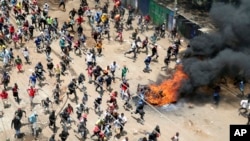More than 20 journalists have been attacked during two weeks of anti-government protests in Kenya. According to the Kenya Media Council, the attacks have increased since the protest began last week, and camerapersons and photographers have become targets of both the state and protesters. The council is demanding that authorities investigate the abuses.
Journalists covering Kenya's anti-government protests have encountered hostility from both police and protesters as they clashed in Nairobi and other parts of the country.
Njeri Gathumbi, a cameraperson for Kenya's Nation Television, said covering this’s week’s protest this week was more difficult than covering last week’s protest.
"If you go on the side of the police, you are in danger of the stones and when you go on the public side, the public will beat you up and you also get teargas from the police,” she said. “Sometimes getting those pictures was a bit difficult, so you had to hide yourself somewhere so that you would get the side of the public and the police, especially when they were exchanging teargas and stones."
The journalists were not specifically targeted until police boss Japhet Koome said photos taken during the demonstration would be used to prosecute the protesters.
The opposition group Azimio la Umoja Coalition, led by Raila Odinga, called for the demonstrations to protest the high cost of living and alleged electoral irregularities.
The government declared the protest illegal and threatened to take action against the organizers and protesters.
Attacks on journalists on Monday and Thursday have been condemned by media organizations, human rights groups and advocates for media freedom and rights.
Victor Bwire, head of media programs at the Media Council of Kenya, said this month’s attacks on journalists have been the worst in recent memory.
"We have recorded over 25 journalists in this month alone who have been harassed, brutally physically attacked, arrested, slept in cells, equipment destroyed or stolen, attacks by mobs who steal their equipment, being profiled in public and TV by politicians,” Bwire said, “and, by extension, being brutally beaten up including with teargas by the police officers who are supposed to secure the right to life of Kenyans."
The Kenya Union of Journalists Secretary General Eric Oduor said journalists covering protests have been targeted for their work.
"If you look at how the attacks were done yesterday, these were the people who were in their car and this officer went straight where the car was,” Oduor said. “They started vandalizing the car so that they could get access to where journalists were, so that they could lob teargas inside the car. You can see it was something targeted, not by accident."
The police have yet to comment on the alleged conduct of some of their officers.
Bwire said media coverage of the weekly protest is helping the public to make an informed decision about their safety.
"Kenyans are entitled to access to information,” Bwire said. "Freedom of expression is enshrined in our constitution and, people who are coming, remember: [In] Nairobi, the central town, [there are] a lot of activities. Once Nairobi is affected … we can get hurt. So, information journalists are giving out there has helped other people to avoid coming to town or knowing what is happening and make an individual decision.”
The media council has urged authorities to investigate and prosecute those responsible for journalist attacks.





